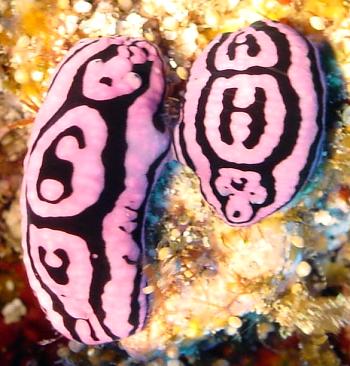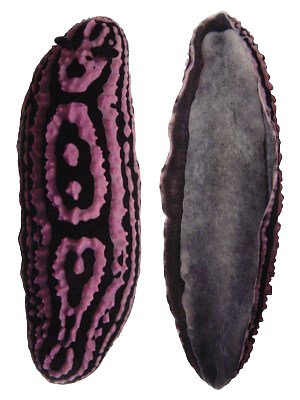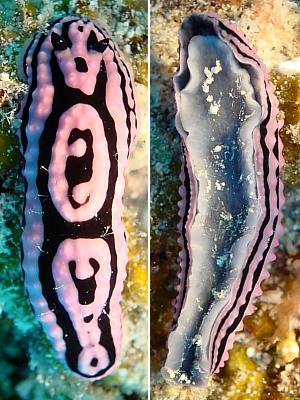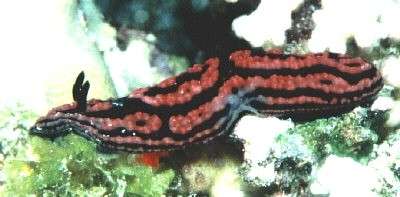
Phyllidiella meandrina
(Pruvot-Fol, 1957)
Order: NUDIBRANCHIA
Suborder: DORIDINA
Superfamily: EUDORIDOIDEA
Family: Phyllidiidae
DISTRIBUTION
Indian Ocean
PHOTO
Upper Right: October 07, 2002. ‘Le platier de la Pointe au Sel’, St-Leu, Reunion Island, Indian Ocean. 40-45mm at 21m. Lower Left: October 06, 2002. ‘Maison Verte’, St-Leu, Reunion Island, Indian Ocean, 50-55mm at 14m. Lower Right: October 16, 2002, ‘Grand Aquarium’, Pereybere, Mauritius, Indian Ocean, 45-50mm at 10m. Photos: Marina Poddubetskaia
P. meandrina is black with pink tubercles. There is a pink band around the mantle edge and inside that there are two tuberculate ridges which encircle the mantle, the outer one being quite narrow and the inner much broader. Down the central part of the mantle the arrangement of the pink tubercles is very characteristic. At the anterior end there are two joined pink rings forming an irregular 'figure of 8' between the rhinophores. The ring behind the rhinophores is larger than the one on front. Behind these rhinophoral rings is a large elongate ring, which has two isolated pink tubercles in the black central region. Behind this ring is another elongate ring with one isolated central tubercle. From the posterior end of this ring is a narrow double ridge running back to join a smaller ring which apparently surrounds the anal papilla. In some animals the ridges are quite sharply tuberculate while in others the tubercles are low giving the ridges are smooth appearance. Another area of variation is the degree of isolation of the tubercles in the centre of the rings. In some specimens they are isolated, while in other specimens they are connected to the surrounding ring by a short ridge. The rhinophores are black, and the underside of the mantle and the foot are a blackish grey. It is probable that the animals I have been calling Phyllidiella cf. annulata, from Christmas Island in the eastern Indian Ocean, which have a pale border to the mantle edge and only one ridge outside the median rings, is a form of P. sudanensis.
Phyllidiella meandrina has similarities to Phyllidiella annulata in having a pattern of rings on the mantle, and to Phyllidiella zeylanica in the arrangement of ridges and the ring of tubercles around the anus. At our present understanding of the species, these animals fit neither species well. In particular, P. annulata has a central row of 4 rings and an outer band of smaller rings. Around the mantle edge are small pink tubercles, and there is no continuous pink edge to the mantle. Although I have no anatomical information, the external shape and colour would suggest that this is a species of Phyllidiella rather than Phyllidia, as redefined by Brunckhorst (1993). I am surprised that Fahrner & Beck (2000) and Fahrner & Schroedl (2000) didn't find this species in their recent reviews of the family.
Brunckhorst (1998) incorrectly considered P. meandrina and its synonym, P. sudanensis (Heller & Thompson, 1983) to be an aberrant specimens of P. annulata. See also Phyllidiella cf. annulata, from the eastern Indian Ocean, which has a pale border to the mantle edge and one pink ridge encircling the mantle, is most probably a form of P. meandrina. See message discussing the identity of this species. P. meandrina was previously identified on the Forum as Phyllidiella cf. zeylanica.
References:
• Brunckhorst, D.J. (1993) The systematics and phylogeny of Phyllidiid Nudibranchs (Doridoidea). Records of the Australian Museum, Supplement 16: 1-107.
• Fahrner, A. & Beck, L.A. (2000) Identification key to the Indo-Pacific species of the nudibranch family Phyllidiidae Rafinesque, 1814, including the description of two new species (Gastropoda: Opisthobranchia). Arch. Molluskenkd., 128: 189-211.
• Fahrner, A. & Schroedl, M. (2000) Redescription of Phyllidiopsis sinaiensis (Yonow, 1988) (Nudibranchia: Phyllidiidae), with a review of the Red Sea Phyllidiidae. J. Moll. Stud., 66: 467-476.
• Heller, J. & Thompson, T.E. (1983) Opisthobranch molluscs of the Sudanese Red Sea. Zoological Journal of the Linnean Society, 78(4): 317-348.
• Pruvot-Fol, A. (1957) Revision de la famille des Phyllidiadae. 2. Journal de Conchyliologie, 97: 104-135, Pl.1.
• Yonow, N. (1986) Red Sea Phyllidiidae (Mollusca: Nudibranchia) with descriptions of new species. Journal of Natural History, 20(6): 1401-1428.
• Yonow, N. & Hayward, P.J. (1991) Opisthobranches de l'Ile Maurice, avec la description de deux especes nouvelles (Mollusca: Opisthobranchia). Revue francaise d'aquariologie, 18(1): 1-30, Figs 1-13.
• Yonow, N., Anderson, R.C. & Buttress, S.G. (2002) Opisthobranch molluscs from the Chagos Archipelago, Central Indian Ocean. Journal of Natural History, 36(7): 831-882


Rudman, W.B., 2002 (November 5) Phyllidiella meandrina (Pruvot-Fol, 1957). [In] Sea Slug Forum. Australian Museum, Sydney. Available from http://www.seaslugforum.net/find/phylmean
Related messages
Re: Phyllidiella meandrina from Indian Ocean [2]
November 28, 2006
From: Hugues Flodrops


Concerning message #18321:
Dear Bill,
Here are further thoughts on Phyllidiella meandrina. I confirm the information of Marina P. I think Phyllidiella meandrina is one of the most common seaslugs of Reunion Is but with a large polymorphism.
Locality: Banc Doré, Saint-Leu, 18 metres, Reunion Island, Indian Ocean, 10 May 2006. Length: 20, 40 et 35 mm. Photographer: Hugues Flodrops.
Here are three pictures to illustrate this during the same diving.
Upper photo: Size: 20 mm.
Middle photo: Size: 40 mm.
Lower photo: Size: 35 mm.
Maybe the third picture is of P. cf annulata?
Thanks for your forum.
Best regards.
Hugues
hugues.flodrops@wanadoo.fr
Flodrops, H, 2006 (Nov 28) Re: Phyllidiella meandrina from Indian Ocean [2]. [Message in] Sea Slug Forum. Australian Museum, Sydney. Available from http://www.seaslugforum.net/find/18323
Dear Hugues,
I think these are all Phyllidiella meandrina, but as I said in response to your last message, working out just what is a species in this genus, is still a work in progress
Best wishes,
Bill Rudman
Re: Phyllidiella meandrina from Indian Ocean [1]
November 28, 2006
From: Hugues Flodrops


Concerning message #8311:
Dear Bill,
These are pictures of probably Phyllidiella meandrina. But in the other hand, the rhinophores look like those of Phyllidiella cf annulata or another species. The criteria to distinguish P. meandrina, P. annulata and P. zeylanica are not clearly defined. The three first pictures are the same seaslug ( Site: Ebouly reef Deep 20 metres Date: 3 november 2006) and the rhinophores details looks like Jorunna.
Locality: Ebouly Reef, 20 m, Reunion Island, Indian Ocean, 3 november 2006. Length: 45 mm. Photographer: Hugues Flodrops
Thanks for yours thoughts.
Best regards.
Hugues
.
hugues.flodrops@wanadoo.fr
Flodrops, H, 2006 (Nov 28) Re: Phyllidiella meandrina from Indian Ocean [1]. [Message in] Sea Slug Forum. Australian Museum, Sydney. Available from http://www.seaslugforum.net/find/18321
Dear Hugues,
I have tried to explain the differences between these species on the P. meandrina Fact Sheet, but there is a possibility that they may not all be good species. The phyllidiids are particularly difficult because they do not have radular teeth. In other groups of nudibranchs we can often distinguish similarly coloured species from one another by finding some internal difference - often in the shape of the radular teeth. If we can link an internal difference with even slight differences in colour pattern, we can then use those colour differences with some confidence. It's not much value to ecologists if they have to dissect every animal they study to know what it is.
Unfortunately with some phyllidiids we are still trying to sort out just what are species and what are colour variants - and the Phyllidiella group contain some of the most problematic 'species'. This is why trying to find animals feeding and laying eggs could be very valuable. They may give us those extra clues we need to decide on what is and what isn't a species.
Best wishes,
Bill Rudman
Phyllidiella meandrina feeding ?
November 28, 2003
From: Marina Poddubetskaia

Dear Bill,
During my collecting mission in Mayotte (the Comoros) I was happy to see again Phyllidiella meandrina, which I saw for the first time in Reunion and Mauritius.
This specimen was found like this : staying quietly on this invertebrate. I'm not sure if it is a sponge or an ascidian. But if it is a sponge, maybe it could be its food ?
Date: November 05, 2003
Location: Mayotte Island, France, Indian Ocean
Site: Passe en S, buoy n° 3
Depth: 7m
Size: 20mm
Cheers,
Marina.
nembro@nembro.info


Dear Marina,
I'm afraid this animal belomgs in a problem area as far as identifications go. It is possibly a variation of P. meandrina but equally it could be a form of Phyllidiella zeylanica. We still have a bit of sorting put to do with this group of species. Concerning the potential food. Again there is an identification problem. It is not always easy to tell for photos but I wouldn't be surprised if the colony was a coelenterate colony - coral or soft coral rather than sponge. But without being able to examine it I couldn't be sure.
Best wishes
Bill Rudman
Re: Phyllidiella meandrina
November 28, 2002
From: Bill Rudman
In a recent message I suggested that Phyllidiella meandrina hadn't been recognised since its original description. I have recently been alerted to two publications which record this species from the Indian Ocean.
• Yonow, N. & Hayward, P.J. (1991) Opisthobranches de l'Ile Maurice, avec la description de deux especes nouvelles (Mollusca: Opisthobranchia). Revue francaise d'aquariologie, 18(1): 1-30, Figs 1-13.
• Yonow, N., Anderson, R.C. & Buttress, S.G. (2002) Opisthobranch molluscs from the Chagos Archipelago, Central Indian Ocean. Journal of Natural History, 36(7): 831-882
Cheers,
Bill Rudman
Phyllidiella meandrina from Indian Ocean [1]
November 8, 2002
From: Marina Poddubetskaia

Dear Bill,
Here are some photos of the most common nudibranchs of Reunion and Mauritius. I think there are 2 different species (but maybe there are more?): Phyllidiella zeylanica and Phyllidiella rosans. Could you help me with these Ids, please?
I saw these phyllidiids in large numbers in all sites I dived. Under the water, they seem quite different and those in this message, which I’m calling Phyllidiella zeylanica are always larger. I've sent some more of this species in a separate message. Is it Phyllidiella zeylanica?
Upper Photo: October 07, 2002 / ‘Le platier de la Pointe au Sel’ / St-Leu, Reunion Island, Indian Ocean / 40-45mm at 21m
Lower Left: October 06, 2002 / ‘Maison Verte’ / St-Leu, Reunion Island, Indian Ocean / 50-55mm at 14m
Lower Right: October 16, 2002 / ‘Grand Aquarium’ / Pereybere, Mauritius, Indian Ocean / 45-50mm at 10m
Photos: Marina Poddubetskaia - Nembro website
I have sent photos of the other species in a separate message.
Best wishes,
Marina.
nembro@nembro.info


Dear Marina,
I am glad you decided to send me lots of photos of even the most common of your finds, because I think you have hit the jackpot with these. I am sure this species is not Phyllidiella zeylanica nor Phyllidiella rosans, and they have significant differences from Phyllidiella annulata. I had previously identified this species on the Forum as Phyllidiella cf. zeylanica. Since you said they were the most common species you saw, I thought it worth hunting through earlier descriptions to see if it had been collected before. It wasn't long before I found Heller & Thompson's photo of Phyllidia sudanensis, and Pruvot-Fol's earlier name, Phyllidia meandrina, which although described from preserved animals, are obviously the same thing.
Brunckhorst (1998) considered both these species to be synonyms of P. annulata, but I would consider the consistent differences in tubercle arrangement to be enough to reinstate this species. If we don't use consistent differences in tubercle arrangement to distinguish species of Phyllidiella we might as well give up and lump them all into P. pustulosa. I suspect the animals from Christmas Island in the eastern Indian Ocean which I have been calling Phyllidiella cf. annulata are also P. meandrina. I have discussed my ideas on this species in a separate message.
Thanks again Marina. I think your photos have helped me sort out at least one problem amongst the phyllidiids.
Best wishes,
Bill Rudman
Phyllidiella meandrina from Indian Ocean [2]
November 8, 2002
From: Marina Poddubetskaia

Dear Bill,
To accompany my earlier message, here is a photo of the most common nudibranchs of Reunion and Mauritius. The sponge it is on may be of interest.
October 16, 2002 / ‘Grand Aquarium’ / Pereybere, Mauritius, Indian Ocean / 45-50mm at 10m Photos: Marina Poddubetskaia - Nembro website
Best wishes,
Marina.
nembro@nembro.info
Poddubetskaia, M., 2002 (Nov 8) Phyllidiella meandrina from Indian Ocean [2]. [Message in] Sea Slug Forum. Australian Museum, Sydney. Available from http://www.seaslugforum.net/find/8312Dear Marina,
This photo showing the yellowish sponge on which this Phyllidiella meandrina is sitting, could be of interest, as I recall it being nearby in a number of your recent photos of phyllidiids. At this stage I can't identify it, but perhaps we should think of it as 'banking' this information so it will be available when we get a sponge expert with a love for nudibranchs to help us out.
best wishes,
Bill Rudman
Rediscovery of Phyllidiella meandrina
November 8, 2002
From: Bill Rudman


I am posting today Marina Poddubetskaia's photos of a phyllidiid, which she reports as commonly found at both Mauritius and Reunion, in the Indian Ocean. The tubercles are arranged in rings, but consistently different from the arrangement found in Phyllidiella annulata. It is also identical with earlier photos on the Forum which I have identified as Phyllidiella cf. zeylanica [see Erwin Koehler's message] and probably the same as those I have been calling Phyllidiella cf. annulata.
PHOTOS: Upper Right: ‘Grand Aquarium’, Pereybere, Mauritius, Indian Ocean. 45-50mm at 10m. October 16, 2002 Photo: Marina Poddubetskaia
Lower: A, Photo of holotype of Phyllidia sudanensis [Heller & Thompson, 1983: Fig. 8J.]. B,C. Holotype of Phyllidia meandrina [Pruvot-Fol, 1957, Figs 22, 23].
This form seems consistent in shape and colour, and is apparently common, in many parts of the Indian Ocean. On looking through the literature I have found two names, Phyllidiella meandrina (Pruvot-Fol, 1957) and P. sudanensis (Heller & Thompson, 1983) which match this animal. Both were considered synonyms of P. annulata by Brunckhorst (1993).
Phyllidia meandrina was described from one preserved specimen in the British Museum [BMNH 1887.6.7.10 - 20mm long preserved, 'Java' 1860-1880?].
Phyllidia sudanensis was described from one 12mm long preserved specimen from the Sudanese Red Sea. The holotype was serially sectioned. Although the published photo suggests a black edge to the mantle, the authors describe 'pale margins of the mantle'
Brunckhorst considered these two species to be synonyms of P. annulata because P. meandrina 'matches' it and P. sudanensis 'corresponds with' it. Having only one specimen of each to compare, it is understandable why Brunckhorst might feel the external features were just strange variations of P. annulata. However it now seems that this 'form' is common throughout the Indian Ocean and is consistently different from P. annulata.
P. meandrina can be described as black with pink tubercles. There is a pink band around the mantle edge and inside that there are two tuberculate ridges which encircle the mantle, the outer one being quite narrow and the inner much broader. Down the central part of the mantle the arrangement of the pink tubercles is very characteristic. At the anterior end there are two joined pink rings forming an irregular 'figure of 8' between the rhinophores. The ring behind the rhinophores is larger than the one on front. Behind these rhinophoral rings is a large elongate ring, which has two isolated pink tubercles in the black central region. Behind this ring is another elongate ring with one isolated central tubercle. From the posterior end of this ring is a narrow double ridge running back to join a smaller ring which apparently surrounds the anal papilla. In some animals the ridges are quite sharply tuberculate while in others the tubercles are low giving the ridges are smooth appearance. Another area of variation is the degree of isolation of the tubercles in the centre of the rings. In some specimens they are isolated, while in other specimens they are connected to the surrounding ring by a short ridge. The rhinophores are black, and the underside of the mantle and the foot are a blackish grey. It is probable that the animals I have been calling Phyllidiella cf. annulata, from Christmas Island in the eastern Indian Ocean, which have a pale border to the mantle edge and only one ridge outside the median rings, is a form of P. sudanensis.
Phyllidiella meandrina has similarities to Phyllidiella annulata in having a pattern of rings on the mantle, and to Phyllidiella zeylanica in the arrangement of ridges and the ring of tubercles around the anus. At our present understanding of the species, these animals fit neither species well. In particular, P. annulata has a central row of 4 rings and an outer band of smaller rings. Around the mantle edge are small pink tubercles, and there is no continuous pink edge to the mantle. Although I have no anatomical information, the external shape and colour would suggest that this is a species of Phyllidiella rather than Phyllidia, as redefined by Brunckhorst (1993). I am surprised that Fahrner & Beck (2000) and Fahrner & Schroedl (2000) didn't find this species in their recent reviews of the family.
References:
• Brunckhorst, D.J. (1993) The systematics and phylogeny of Phyllidiid Nudibranchs (Doridoidea). Records of the Australian Museum, Supplement 16: 1-107.
• Fahrner, A. & Beck, L.A. (2000) Identification key to the Indo-Pacific species of the nudibranch family Phyllidiidae Rafinesque, 1814, including the description of two new species (Gastropoda: Opisthobranchia). Arch. Molluskenkd., 128: 189-211.
• Fahrner, A. & Schroedl, M. (2000) Redescription of Phyllidiopsis sinaiensis (Yonow, 1988) (Nudibranchia: Phyllidiidae), with a review of the Red Sea Phyllidiidae. J. Moll. Stud., 66: 467-476.
• Heller, J. & Thompson, T.E. (1983) Opisthobranch molluscs of the Sudanese Red Sea. Zoological Journal of the Linnean Society, 78(4): 317-348.
• Pruvot-Fol, A. (1957) Revision de la famille des Phyllidiadae. 2. Journal de Conchyliologie, 97: 104-135, Pl.1.
• Yonow, N. (1986) Red Sea Phyllidiidae (Mollusca: Nudibranchia) with descriptions of new species. Journal of Natural History, 20(6): 1401-1428.
More on Phyllidiella pustulosa? from Mauritius
September 14, 1999
From: Erwin Koehler


Bill,
Fred writes the Phy. pustulosa / annulata slugs are common at Mauritius, (not Philippines where you placed them,) up to 20 m depth. Here are two more photos of others specimens.
UPPER: depth 10m, LOWER: depth 17 m
I will post them at my web-site as Phyllidiella sp.
Erwin
Medslugs.Koehler@t-online.de
Koehler, E., 1999 (Sep 14) More on Phyllidiella pustulosa? from Mauritius. [Message in] Sea Slug Forum. Australian Museum, Sydney. Available from http://www.seaslugforum.net/find/1338Note added 7 November 2002: I have identified this as P. meandrina. - Bill Rudman
Dear Erwin,
Sorry for the locality slip up, which I have corrected. The side view showing the edge of the mantle shows it doesn't have the pale edge considered typical of Phyllidiella pustulosa, and one point I should have realised is that P. pustulosa doesn't have the tubercles arranged in ridges, as these Mauritian animals clearly do. They still don't look like typical Phyllidiella annulata. Perhaps they are a form of Phyllidiella zeylanica, which does have ridges and shows some development of the median ridges in to circles. Phyllidiella zeylanica also has a ring of tubercles around the anus which can be seen in both phtos above.
Bill Rudman.
Rudman, W.B., 1999 (Sep 14). Comment on More on Phyllidiella pustulosa? from Mauritius by Erwin Koehler. [Message in] Sea Slug Forum. Australian Museum, Sydney. Available from http://www.seaslugforum.net/find/1338Phyllidiella annulata? from Mauritius
September 13, 1999
From: Erwin Koehler

Bill,
This one was taken by Fred Vogt, Hamburg, Germany at Mauritius, April 1999 size and depth unrecorded.
Is it Phyllidiella annulata (Gray, 1853)?
Erwin
Medslugs.Koehler@t-online.de
Koehler, E., 1999 (Sep 13) Phyllidiella annulata? from Mauritius. [Message in] Sea Slug Forum. Australian Museum, Sydney. Available from http://www.seaslugforum.net/find/1326Note added 7 November 2002: I have identified this as P. meandrina. - Bill Rudman
Dear Erwin,
My first thoughts were yes it is Phyllidiella annulata but on reflection I think it is a peculiar form of P. pustulosa in which some of the central clusters of tubercles have formed into rings. I'm afraid it all comes down to a question of definition. Brunckhorst compares the two species and says that in P. annulata there is a distinctive colour pattern of pink rings with, small low tubercles, on a black background. There is no central tubercle to each ring. He says P. annulata lacks the compound tubercles and tubercular clusters found in P. pustulosa. P. pustulosa also has a thin pink mantle border.
If this is so, then this animal doesn't fit the definition of P. annulata. I don't like saying 'something doesn't fit the definition' because 'definitions' are man-made and need to be changed if they don't fit the 'facts'. However, although this photo certainly looks like an intermediate between the two species, I think we would need further information to be sure. All I can say is that if the two are good species then I would guess that this animal is a from of P. pustulosa.
Bill Rudman.
